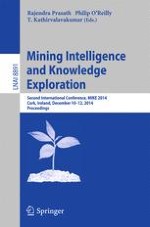2014 | Buch
Mining Intelligence and Knowledge Exploration
Second International Conference, MIKE 2014, Cork, Ireland, December 10-12, 2014. Proceedings
herausgegeben von: Rajendra Prasath, Philip O’Reilly, T. Kathirvalavakumar
Verlag: Springer International Publishing
Buchreihe : Lecture Notes in Computer Science
